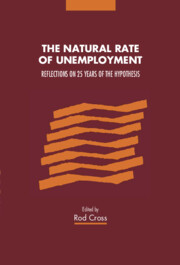Book contents
- Frontmatter
- Contents
- List of Contributors
- Preface
- 1 Introduction
- Part I The theoretical framework
- Part II Adjustment, ranges of equilibria and hysteresis
- 6 The economics of adjustment
- 7 Hysteresis and memory in the labour market
- 8 Models of the range of equilibria
- 9 Hysteresis revisited: a methodological approach
- 10 Is the natural rate hypothesis consistent with hysteresis?
- Part III Empirical tests and macro models
- Part IV Political economy
- Index
10 - Is the natural rate hypothesis consistent with hysteresis?
Published online by Cambridge University Press: 03 May 2011
- Frontmatter
- Contents
- List of Contributors
- Preface
- 1 Introduction
- Part I The theoretical framework
- Part II Adjustment, ranges of equilibria and hysteresis
- 6 The economics of adjustment
- 7 Hysteresis and memory in the labour market
- 8 Models of the range of equilibria
- 9 Hysteresis revisited: a methodological approach
- 10 Is the natural rate hypothesis consistent with hysteresis?
- Part III Empirical tests and macro models
- Part IV Political economy
- Index
Summary
Hysteresis effects are distinct in that they remain after the initial causes are removed. The term itself is derived from the Greek ύστερέω meaning to come later, and was first coined for the explanation of scientific phenomena by the physicist James Alfred Ewing (1881a). The initial application was to the thermo-electric properties of metals when subjected to stress by loading and unloading, the more celebrated application being to the behaviour of electromagnetic fields in ferric metals (Ewing, 1881b, 1885, 1893). The non-hysteretic account of electromagnetic fields in Maxwell's equations had the property that the application of a once-off magnetising force would have no remaining effect on field characteristics once the force was removed. Ewing's studies revealed that this was not the case for ferric metals, and the term ‘hysteresis’ was coined to describe this phenomenon (see Cross and Allan, 1988; Cross, 1993).
The standard definition of the natural rate of unemployment (Phelps, 1967; Friedman, 1968) as depending on ‘the actual structural characteristics of the labour and commodity markets, including market imperfections, stochastic variability in demands and supplies, the cost of gathering information about job vacancies and labour availabilities, the costs of mobility, and so on’ (Friedman, 1968, p. 8) does not in itself preclude hysteresis: temporary shocks affecting actual unemployment, for example, could have permanent effects on the ‘structural characteristics of labour and commodity markets’, and consequently on the natural rate.
- Type
- Chapter
- Information
- The Natural Rate of UnemploymentReflections on 25 Years of the Hypothesis, pp. 181 - 200Publisher: Cambridge University PressPrint publication year: 1995
- 20
- Cited by



